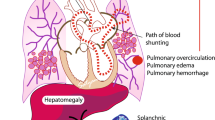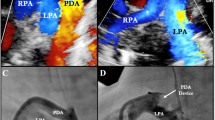Abstract
Objective
Evaluate spontaneous closure of the patent ductus arteriosus (PDA) in extremely preterm infants and their respiratory outcomes, especially at <26 weeks gestational age (GA).
Study design
Retrospective study in <29 weeks, admitted within 24 h after birth (Feb 2015 and Dec 2019). Infants without any intervention to promote ductal closure, ≥1 echocardiography, and alive at discharge were included.
Results
Two hundred and fourteen infants (average GA 26.3 ± 1.5 weeks) were included; 84 (39%) <26 weeks. PDA closed spontaneously in 194 (91%); 76/84 (90%) for infants <26 weeks. PDA closure was ascertained on an echocardiography performed at a median age of 36.4 [34.4–40.1] weeks. Rate of moderate-to-severe bronchopulmonary dysplasia decreased throughout the study period (OR for year of birth: 0.70 [95% CI: 0.57–0.87], p = 0.001).
Conclusion
Majority of extremely preterm infants, including <26 weeks, had spontaneous closure of the ductus before term corrected age. There was a concomitant improvement of respiratory outcomes.
This is a preview of subscription content, access via your institution
Access options
Subscribe to this journal
Receive 12 print issues and online access
$259.00 per year
only $21.58 per issue
Buy this article
- Purchase on Springer Link
- Instant access to full article PDF
Prices may be subject to local taxes which are calculated during checkout

Similar content being viewed by others
References
Laughon M, O’Shea MT, Allred EN, Bose C, Kuban K, Van Marter LJ, et al. Chronic lung disease and developmental delay at 2 years of age in children born before 28 weeks’ gestation. Pediatrics. 2009;124:637–48.
Altit G, Dancea A, Renaud C, Perreault T, Lands LC, Sant’Anna G. Pathophysiology, screening and diagnosis of pulmonary hypertension in infants with bronchopulmonary dysplasia-a review of the literature. Paediatr Respir Rev. 2017;23:16–26.
Lemyre B, Moore G. Counselling and management for anticipated extremely preterm birth. Paediatr Child Health. 2017;22:334–41.
Stoll BJ, Hansen NI, Bell EF, Walsh MC, Carlo WA, Shankaran S, et al. Trends in care practices, morbidity, and mortality of extremely preterm neonates, 1993-2012. Jama. 2015;314:1039–51.
Semberova J, Sirc J, Miletin J, Kucera J, Berka I, Sebkova S, et al. Spontaneous closure of patent ductus arteriosus in infants ≤1500 g. Pediatrics. 2017;140:2.
Sung SI, Chang YS, Kim J, Choi JH, Ahn SY, Park WS. Natural evolution of ductus arteriosus with noninterventional conservative management in extremely preterm infants born at 23-28 weeks of gestation. PLoS ONE. 2019;14:1–11.
Rolland A, Shankar-Aguilera S, Diomandé D, Zupan-Simunek V, Boileau P. Natural evolution of patent ductus arteriosus in the extremely preterm infant. Arch Dis Child Fetal Neonatal Ed. 2015;100:F55–8.
Urquhart DS, Nicholl RM. How good is clinical examination at detecting a significant patent ductus arteriosus in the preterm neonate? Arch Dis Child. 2003;88:85–6.
Benitz WE, Committee on Fetus and Newborn, American Academy of Pediatrics. Patent ductus arteriosus in preterm infants. Pediatrics. 2016;137:1–6.
Benitz WE, Bhombal S. The use of non-steroidal anti-inflammatory drugs for patent ductus arteriosus closure in preterm infants. Semin Fetal Neonatal Med. 2017;22:302–7.
Mitra S, Florez ID, Tamayo ME, Mbuagbaw L, Vanniyasingam T, Veroniki AA, et al. Association of placebo, indomethacin, ibuprofen, and acetaminophen with closure of hemodynamically significant patent ductus arteriosus in preterm infants: a systematic review and meta-analysis. Jama. 2018;319:1221–38.
Benitz W. Learning to live with patency of the ductus arteriosus in preterm infants. J Perinatol. 2011;31:S42.
Benitz WE. Patent ductus arteriosus: to treat or not to treat? Arch Dis Child Fetal Neonatal Ed. 2012;97:F80–2.
Benitz WE. Treatment of persistent patent ductus arteriosus in preterm infants: time to accept the null hypothesis? J Perinatol. 2010;30:241–52.
Laughon M, Bose C, Benitz WE. Patent ductus arteriosus management: what are the next steps? J Pediatr. 2010;157:355–7.
Laughon MM, Simmons MA, Bose CL. Patency of the ductus arteriosus in the premature infant: is it pathologic? Should it be treated? Curr Opin Pediatr. 2004;16:146–51.
Clyman RI, Chorne N. Patent ductus arteriosus: evidence for and against treatment. J Pediatr. 2007;150:216–9.
Perez KM, Laughon MM. What is new for patent ductus arteriosus management in premature infants in 2015? Curr Opin Pediatr. 2015;27:158–64.
Chock VY, Punn R, Oza A, Benitz WE, Van Meurs KP, Whittemore AS, et al. Predictors of bronchopulmonary dysplasia or death in premature infants with a patent ductus arteriosus. Pediatr Res. 2014;75:570–5.
Altit G, Saeed S, Beltempo M, Claveau M, Lapointe A, Basso O. Outcomes of extremely premature infants comparing patent ductus arteriosus management approaches. J Pediatr. 2021;235:49–57.
Higgins RD, Jobe AH, Koso-Thomas M, Bancalari E, Viscardi RM, Hartert TV, et al. Bronchopulmonary dysplasia: executive summary of a workshop. J Pediatrics. 2018;197:300–8.
Fenton TR, Kim JH. A systematic review and meta-analysis to revise the Fenton growth chart for preterm infants. BMC Pediatr. 2013;13:59.
Canadian Neonatal Network - Annual Report. Postnatal use of steroids for treatment of Chronic Lung Disease in GA < 29 weeks. Annual Report by the Canadian Neonatal Network (CNN). WebLink: http://www.canadianneonatalnetwork.org/portal/Portals/0/Annual%20Reports/2019%20CNN%20report%20final_links.pdf. 2019:1–145. Accessed November 2021.
Jobe AH, Bancalari E. Bronchopulmonary dysplasia. Am J Respir Crit Care Med. 2001;163:1723–9.
Neu J. Necrotizing enterocolitis: the search for a unifying pathogenic theory leading to prevention. Pediatr Clin North Am. 1996;43:409–32.
Bell MJ, Ternberg JL, Feigin RD, Keating JP, Marshall R, Barton L, et al. Neonatal necrotizing enterocolitis. Therapeutic decisions based upon clinical staging. Ann Surg. 1978;187:1.
Papile L-A, Burstein J, Burstein R, Koffler H. Incidence and evolution of subependymal and intraventricular hemorrhage: a study of infants with birth weights less than 1,500 gm. J Pediatr. 1978;92:529–34.
Kluckow M, Jeffery M, Gill A, Evans N. A randomised placebo-controlled trial of early treatment of the patent ductus arteriosus. Arc Dis Child Fetal Neonatal Ed. 2014;99:F99–F104.
Richardson DK, Corcoran JD, Escobar GJ, Lee SK. SNAP-II and SNAPPE-II: simplified newborn illness severity and mortality risk scores. J Pediatr. 2001;138:92–100.
CNN. Patient log—Admission screen definitions—Canadian Neonatal Network—Abstractor’s Manual. 2012. http://www.canadianneonatalnetwork.org/Portal/LinkClick.aspx?fileticket=I3jnvN9fGfE%3D&tabid=69.
El-Khuffash AF, Jain A, McNamara PJ. Ligation of the patent ductus arteriosus in preterm infants: Understanding the physiology. J Pediatr. 2013;162:1100–6.
Germain A, Nouraeyan N, Claveau M, Leone M, Sant’Anna G. “Optimal surfactant delivery protocol using the bovine lipid extract surfactant: a quality improvement study”. J Perinatol. 2021;41:17–23.
Weber SC, Weiss K, Bührer C, Hansmann G, Koehne P, Sallmon H. Natural history of patent ductus arteriosus in very low birth weight infants after discharge. J Pediatr. 2015;167:1149–51.
Patel RM, Kandefer S, Walsh MC, Bell EF, Carlo WA, Laptook AR, et al. Causes and timing of death in extremely premature infants from 2000 through 2011. N Engl J Med. 2015;372:331–40.
Vollsæter M, Clemm HH, Satrell E, Eide GE, Røksund OD, Markestad T, et al. Adult respiratory outcomes of extreme preterm birth. A regional cohort study. Ann Am Thorac Soc. 2015;12:313–22.
Lazdam M, de la Horra A, Pitcher A, Mannie Z, Diesch J, Trevitt C, et al. Elevated blood pressure in offspring born premature to hypertensive pregnancy: is endothelial dysfunction the underlying vascular mechanism? Hypertension. 2010;56:159–65.
Doyle LW, Cheong JLY. Postnatal corticosteroids to prevent or treat bronchopulmonary dysplasia—who might benefit? Semin Fetal Neonatal Med. 2017;22:290–5.
Doyle LW, Davis PG, Morley CJ, McPhee A, Carlin JB. Outcome at 2 years of age of infants from the DART study: a multicenter, international, randomized, controlled trial of low-dose dexamethasone. Pediatrics. 2007;119:716–21.
Doyle LW, Davis PG, Morley CJ, McPhee A, Carlin JB. Low-dose dexamethasone facilitates extubation among chronically ventilator-dependent infants: a multicenter, international, randomized, controlled trial. Pediatrics. 2006;117:75–83.
Doyle LW, Ehrenkranz RA, Halliday HL. Late (>7 days) postnatal corticosteroids for chronic lung disease in preterm infants. Cochrane Database Syst Rev. 2014:CD001145.
Halliday HL. Update on postnatal steroids. Neonatology. 2017;111:415–22.
Morales P, Rastogi A, Bez ML, Akintorin SM, Pyati S, Andes SM, et al. Effect of dexamethasone therapy on the neonatal ductus arteriosus. Pediatr Cardiol. 1998;19:225–9.
Takami T, Momma K, Imamura S. Increased constriction of the ductus arteriosus by dexamethasone, indomethacin, and rofecoxib in fetal rats. Circ J. 2005;69:354–8.
Keszler M, Sant’Anna G. Mechanical ventilation and bronchopulmonary dysplasia. Clin Perinatol. 2015;42:781–96.
Clyman RI, Liebowitz M, Kaempf J, Erdeve O, Bulbul A, Hakansson S, et al. PDA-TOLERATE trial: an exploratory randomized controlled trial of treatment of moderate-to-large patent ductus arteriosus at 1 week of age. J Pediatr. 2019;205:41–8.e6.
Acknowledgements
We acknowledge the support of the Canadian Neonatal Network who provided the local data for our center.
Funding
This work was supported by the Department of Pediatrics of the MUHC (Pilot Grant), by Just for Kids Foundation and the Montreal Children’s Hospital Foundation. The funder/sponsor did not participate in the work.
Author information
Authors and Affiliations
Contributions
GdCN conceptualized and designed the study, collected the data, analyzed the data, drafted the paper, and adjusted the paper according to the comments of co-authors. PW and JS collected the data and revised the paper. MB conceptualized and designed the study, collected the data, critically appraised the analysis of the data and reviewed and revised the paper. GMSA critically appraised the analysis of the data, reviewed, and revised the paper. GA conceptualized and designed the study, supervised data collection, critically appraised the analysis of the data, wrote, and critically reviewed the paper for important intellectual content. All authors approved the final paper as submitted and agree to be accountable for all aspects of the work.
Corresponding author
Ethics declarations
Competing interests
The authors declare no competing interests.
Ethics approval and consent to participate
The study was performed in accordance with the Declaration of Helsinki and was approved by the McGill University Health Center research ethics boards.
Additional information
Publisher’s note Springer Nature remains neutral with regard to jurisdictional claims in published maps and institutional affiliations.
Supplementary information
Rights and permissions
About this article
Cite this article
de Carvalho Nunes, G., Wutthigate, P., Simoneau, J. et al. Natural evolution of the patent ductus arteriosus in the extremely premature newborn and respiratory outcomes. J Perinatol 42, 642–648 (2022). https://doi.org/10.1038/s41372-021-01277-2
Received:
Revised:
Accepted:
Published:
Issue Date:
DOI: https://doi.org/10.1038/s41372-021-01277-2
This article is cited by
-
Early cardiac function and death, severe bronchopulmonary dysplasia and pulmonary hypertension in extremely preterm infants
Pediatric Research (2024)
-
Evaluation of the association between patent ductus arteriosus approach and neurodevelopment in extremely preterm infants
Journal of Perinatology (2024)
-
The role of furosemide and fluid management for a hemodynamically significant patent ductus arteriosus in premature infants
Journal of Perinatology (2022)
-
Is early patent ductus arteriosus ligation helpful in premature neonates? A 10-year retrospective study
World Journal of Pediatrics (2022)



